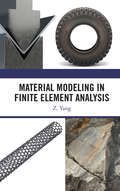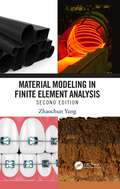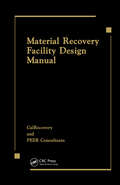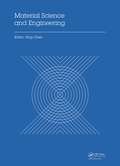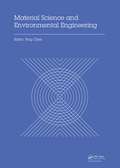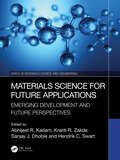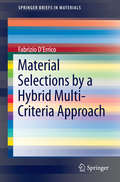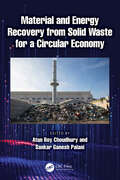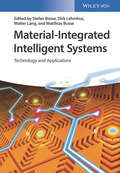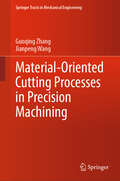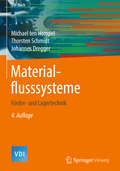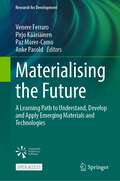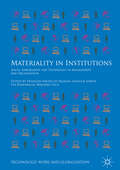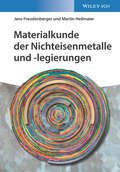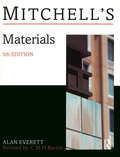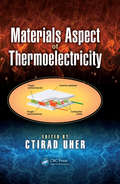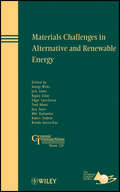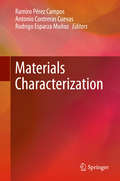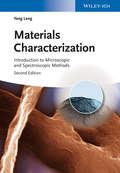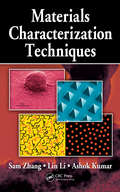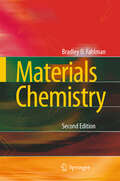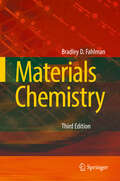- Table View
- List View
Material Inhomogeneities in Elasticity
by G.A. MauginSelf contained, this book presents a thorough introduction to the complementary notions of physical forces and material (or configurational) forces. All the required elements of continuum mechanics, deformation theory and differential geometry are also covered. This book will be a great help to many, whilst revealing to others a rather new facet of continuum mechanics in general, and elasticity in particular. An organized exposition of continuum mechanics on the material manifold is given which allows for the consideration of material inhomogeneities in their most appropriate framework. In such a frame the nonlinear elasticity of anisotropic inhomogenous materials appears to be a true field theory. Extensions to the cases of electroelasticity and magnetelasticity are then straightforward. In addition, this original approach provides systematic computational means for the evaluation of characteristic parameters which are useful in various branches of applied mechanics and mathematical physics. This is the case for path-independent integrals and energy-release rates in brittle fracture, the influence of electromagnetic fields on fracture criteria (such as in ceramics), the notion of momentum of electromagnetic fields in matter in optics, and the perturbation of solitons propagating in elastic dispersive systems.
Material Modeling in Finite Element Analysis
by Z. YangFinite element analysis has been widely applied in mechanical, civil, and biomedical designs. This book aims to provide the readers comprehensive views of various material models with practical examples, which would help readers understand various materials, and build appropriate material models in the finite element analysis. This book is composed of four main parts: 1) metals, 2) polymers, 3) soils, and 4) modern materials. Each part starts with the structure and function of different materials and then follows the corresponding material models such as BISO, MISO, Chaboche model in metals, Arruda-Boyce model, Mooney-Rivlin model, Ogden model in polymers, Mohr-Coulomb model, Cam Clay model and Jointed Rock model in geomechanics, composites and shape memory alloys in modern materials. The final section presents some specific problems, such as metal forming process, combustion chamber, Mullins effect of rubber tire, breast shape after breast surgery, viscoelasticity of liver soft tissues, tunnel excavation, slope stability, orthodontic wire, and piezoelectric microaccelerometer. All modeling files are provided in the appendixes of the book. This book would be helpful for graduate students and researchers in the mechanical, civil, and biomedical fields who conduct finite element analysis. The book provides all readers with comprehensive understanding of modeling various materials.
Material Modeling in Finite Element Analysis
by Zhaochun YangFinite element analysis has been widely applied in mechanical, civil, and biomedical designs. This new edition provides the readers with comprehensive views of various material models through practical examples, which will help them better understand various materials and build appropriate material models in finite element analysis. Material Modeling in Finite Element Analysis, Second Edition, consists of four main parts: (1) metals, (2) polymers, (3) soils, and (4) modern materials. Each part starts with the structure and function of different materials and then follows the corresponding material models and the temperature and time effects on the material models. The final part focuses on user subroutines such as UserMat and UserHyper. This book presents some specific problems including the metal-forming process, combustion room, Mullins effect of rubber tires, viscoelasticity of liver soft tissues, small punch test, tunnel excavation, slope stability, concrete slump test, orthodontic wire, and piezoelectric microaccelerometer. All modeling files are provided in the appendices of this book. This book would be helpful for graduate students and researchers in the mechanical, civil, and biomedical fields who conduct finite element analysis. This book provides all readers with a comprehensive understanding of modeling various materials.
Material Recovery Facility Design Manual
by 0 Peer Consultants CallRecoveryEconomic factors discussed include purchase price, utility requirements, maintenance costs, labor costs, auxiliary equipment purchase needs, sizing, space requirements, redundancy requirements, and all aspects necessary for the development of performance and equipment specifications. Material Recovery Facility Design Manual is essential for solid waste planners, engineers, and anyone else involved with startup, implementation, and acceptance testing of MRF equipment and systems.
Material Science and Engineering: Proceedings of the 3rd Annual 2015 International Conference on Material Science and Engineering (ICMSE2015, Guangzhou, Guangdong, China, 15-17 May 2015)
by Ping ChenMaterial Science and Engineering presents novel and fundamental advances in the field of material science and engineering. This proceedings collects the comprehensive and worldwide research results on Metallic Materials and Applications, Chemical Materials, Electronic Materials, Nanomaterials, Composite and Polymer Materials, Bio and Medical Materi
Material Science and Environmental Engineering: Proceedings of the 3rd Annual 2015 International Conference on Material Science and Environmental Engineering (ICMSEE2015, Wuhan, Hubei, China, 5-6 June 2015)
by Ping ChenMaterial Science and Environmental Engineering presents novel and fundamental advances in the fields of material science and environmental engineering. Collecting the comprehensive and state-of-art in these fields, the contributions provide a broad overview of the latest research results, so that it will proof to be a valuable reference book to aca
Material Science for Future Applications: Emerging Development and Future Perspectives (Series in Materials Science and Engineering)
by Abhijeet R. Kadam Kranti R. Zakde Swart, Sanjay J. Dhoble and Hendrik C.Materials Science for Future Applications: Emerging Development and Future Perspectives offers an overview of the materials used for progressive energy systems, such as solar cells, luminescent energy, sensors and detectors and energy storage devices. Today’s worldwide energy and materials production is going through important changes, which are developing novel prospects. These developments and innovative technologies are changing the way energy is manufactured, transported and spent.The materials emphasis in this book conveys a new perspective and highlights the many challenges that are often overlooked in other literature. An understanding of these challenges can be critical when working with new energy material technologies. Particular devotion is given to the key materials and their conversion productivity, extensive duration of permanency, materials expenses and energy materials sustainability.Materials Science for Future Applications offers a comprehensive introduction for students and researchers, in both academia and industry, who are interested in understanding the properties of emerging materials and their challenges.
Material Selections by a Hybrid Multi-Criteria Approach
by Fabrizio D'ErricoThis Brief presents a new method that is based on the author and his students' shared experience in applying a structured procedure that has as its main goal the creation of a material selection technique that uses language and employs a platform that is not restricted to engineers. Based on a hybrid approach that exploits both traditional and semi-quantitative concepts, it moves forward step-by step, and uses a platform based on a Quality Function Deployment matrix framework. Candidate materials are screened out and finally assessed by two user-friendly graphic analysis tools, one based on the value curve of the product and the other on an original Bubble Maps tool. The Brief is written for all those whose aim is for a better understanding of how to integrate and speed up the entire product development process from the initial product concept and engineering design phases to design specs, manufacturability and product marketing with optimal choice of materials.
Material and Energy Recovery from Solid Waste for a Circular Economy
by Sankar Ganesh Palani Atun Roy ChoudhuryMaterial and Energy Recovery from Solid Waste for a Circular Economy describes solid waste to material and energy recovery to bridge the gap between theoretical possibilities and on-field criticalities. It deals with various resource recovery possibilities from numerous waste streams such as municipal solid, hazardous waste, human faecal sludge, construction and demolition waste, and electronic waste. The practical issues of resource recovery and possible remedies derived through onsite practice and experience are incorporated. It includes real-life feasibility analysis and implementation of waste-to-energy systems supported by case studies.Features: Provides comprehensive discussion on both energy and material recovery Addresses the missing linkage between the techno-commercial feasibility of existing systems and environmental impact Discusses techno-commercial feasibility and environmental impacts Offers balance between theoretical knowledge sharing and practical execution-related issues Includes case study, LCA, and technical feasibility chapters This book is aimed at graduate students and researchers in environmental, civil, and chemical engineering.
Material-Integrated Intelligent Systems: Technology and Applications
by Matthias Busse Dirk Lehmhus Stefan Bosse Walter LangCombining different perspectives from materials science, engineering, and computer science, this reference provides a unified view of the various aspects necessary for the successful realization of intelligent systems. The editors and authors are from academia and research institutions with close ties to industry, and are thus able to offer first-hand information here. They adopt a unique, three-tiered approach such that readers can gain basic, intermediate, and advanced topical knowledge. The technology section of the book is divided into chapters covering the basics of sensor integration in materials, the challenges associated with this approach, data processing, evaluation, and validation, as well as methods for achieving an autonomous energy supply. The applications part then goes on to showcase typical scenarios where material-integrated intelligent systems are already in use, such as for structural health monitoring and smart textiles.
Material-Oriented Cutting Processes in Precision Machining (Springer Tracts in Mechanical Engineering)
by Jianpeng Wang Guoqing ZhangThis book studies the influence of material properties on the precision machining process from a microscopic perspective. In the present book, the properties of single crystal materials, polycrystalline materials, amorphous materials, ferrous materials, diamond tool materials, size effects and their influence on the cutting process and performance in precision machining are proposed. Moreover, the cutting mechanism and surface generation as machining different materials are presented, also some cutting process optimizations are suggested to improve the cutting processes. This book aims to provide a variety of feasible machining technology and advanced cutting processes for machining different kinds of materials. Since the book focuses on the materials' oriented precision processes, it encompasses both materials science and machining technologies. Graduate students, researchers and engineering technicians in related research fields will benefit from this book.
Materialflusssysteme: Förder- Und Lagertechnik (VDI-Buch)
by Michael Ten Hompel Thorsten Schmidt Johannes DreggerIntralogistik: lagern – transportieren - zusammenführen – verteilen. Auch die 3., völlig neu bearbeitete Auflage gibt einen grundlegenden und vollständigen Überblick über alle Komponenten zur Erfüllung zentraler logistischer Funktionen. Zahlreiche Tabellen, Grafiken und technische Daten, eine Fülle konkreter Systembeispiele und Auswahlmöglichkeiten unterstützen sowohl Studierende als auch Praktiker, Planer und Entscheider bei ihrer Arbeit.
Materialising the Future: A Learning Path to Understand, Develop and Apply Emerging Materials and Technologies (Research for Development)
by Venere Ferraro Pirjo Kääriäinen Paz Morer-Camo Anke PasoldThis open access book offers a host of theoretical knowledge at the basis of new EM&Ts (namely, Interactive Connected Smart Materials, Wearables (ICS), Nanomaterials, Advanced Growing Materials, and Experimental Wood-Based Materials), as communicated through the unique design teaching method developed within the context of the European Project DATEMATS, a result of the creative workshops held by the four higher education institutions that were partners in the project, stressing the pros and cons of the method and offering ideas for further development and improvement. The modern age requires its own innovations in regards to both social and industrial progress, innovations made possible by Emerging Materials and Technologies (EM&Ts). Frameworks for designing both with and for the new materials are presented, educating designers about the opportunities offered by EM&Ts and how to take advantage of them. At the same time, the book explains how the method developed through the knowledge generated at research centers and universities can be communicated to companies across various industries that stand to gain from it, linking the assorted stakeholders, and includes a final chapter based on feedback from both students and business professionals as to the benefits of academic/industrial cooperation. This is an open access book.
Materiality in Institutions: Spaces, Embodiment And Technology In Management And Organization (Technology, Work And Globalization Ser.)
by Bernard Leca Eva Boxenbaum François-Xavier de Vaujany Anouck AdrotThis book aims at clarifying the role of materiality, spaces, digitality and embodiment in institutional dynamics from the perspective of Management & Organization Studies. Presenting a rich set of theoretical, methodological and epistemological advances on materiality and institutions, it also gives voice to distinctive and diverse perspectives on materiality in institutions, structuring chapters into four major topics: artefacts and objects, digitality and information, space and time, body and embodiment. This book sparks discussion and debate about ontological dimensions of Management & Organization Studies, including post-discursive, visual, phenomenological and material.
Materialkunde der Nichteisenmetalle und -legierungen
by Jens Freudenberger Martin HeilmaierAktuelles Lehrbuch zur Materialkunde der Nichteisenmetalle - kompakt, übersichtlich, verständlich Die Werkstoffklasse der Nichteisenmetalle ist groß: man teilt sie ein in Leicht-, Bunt-, Alkali- und Erdalkalimetalle, hochschmelzende und Refraktärmetalle sowie Metalle der Platingruppe und Edelmetalle. Diese Vielfalt der (teilweise überlappenden) Klassifizierungen entspricht den unzähligen Anwendungsmöglichkeiten der Nichteisenmetalle, die im Blick auf die technische und wirtschaftliche Bedeutung den eisenbasierten Werkstoff en in nichts nachstehen. Daher spielen die Nichteisenmetalle auch in der Hochschullehre für Studierende der Material- und Werkstoffwissenschaften und des Maschinenbaus eine immer größere Rolle. Materialkunde der Nichteisenmetalle und -legierungen gibt eine Einführung in die Materialphysik der Nichteisenmetalle und ihrer Legierungen mit dem Fokus auf Darstellung, Konstitution, Gefüge, mechanische und physikalische Eigenschaften, die den Einsatz in der Anwendung bestimmen. Kompakt und klar strukturiert erlangen die Leserinnen und Leser einen Überblick über die Leistungsfähigkeit der Nichteisenmetalle und deren Grenzen und erwerben die Kompetenz, die Einsatzmöglichkeiten anhand der jeweiligen Eigenschaften zu bewerten. * Klar strukturiert: in einheitlich aufgebauten Kapiteln werden die wichtigsten Nichteisenmetalle und ihre Legierungen dargestellt, stets im Zusammenhang mit ihren Anwendungen * Top Team: die Autoren verfügen über langjährige Lehrerfahrung und gehören zu den bekanntesten Werkstoffwissenschaftlern Deutschlands Materialkunde der Nichteisenmetalle und -legierungen richtet sich an Bachelor- und Master-Studenten der Materialwissenschaften, Master-Studenten der Physik und Chemie, Ingenieurstudenten, sowie an Materialwissenschaftler und Metallurgen.
Materials (Mitchell's Building Series)
by Alan Everett C. M. BarrittA well-known and respected standard reference, this fifth edition provides a thorough treatment of the properties of building materials and their manufacture, both on-site and in the factory.
Materials Aspect of Thermoelectricity
by Ctirad UherIn recent years, novel families of materials have been discovered and significant improvements in classical thermoelectric materials have been made. Thermoelectric generators are now being used to harvest industrial heat waste and convert it into electricity. This is being utilized in communal incinerators, large smelters, and cement plants. Leading car and truck companies are developing thermoelectric power generators to collect heat from the exhaust systems of gasoline and diesel engines. Additionally, thermoelectric coolers are being used in a variety of picnic boxes, vessels used to transport transplant organs, and in air-conditioned seats of mid-size cars. Consisting of twenty-one chapters written by top researchers in the field, this book explores the major advancements being made in the material aspects of thermoelectricity and provides a critical assessment in regards to the broadening of application opportunities for thermoelectric energy conversion.
Materials Challenges in Alternative and Renewable Energy: Ceramic Transactions (Ceramic Transactions Series #224)
by George Wicks Jack Simon Ragaiy Zidan Edgar Lara-Curzio Thad Adams Jose Zayas Abhi Karkamkar Robert Sindelar Brenda Garcia-DiazThis useful, one-stop resource for understanding the most important issues in materials challenges in alternative and renewable energy. The logically organized and carefully selected articles give insight into materials challenges in alternative renewable energy and incorporate the latest developments related to materials challenges in alternative renewable energy, including hydrogen, batteries and energy storage materials, hydropower, and biomass.
Materials Characterization
by Ramiro Pérez Campos Antonio Contreras Cuevas Rodrigo Esparza MuñozThis book covers novel research results for process and techniques of materials characterization for a wide range of materials. The authors provide a comprehensive overview of the aspects of structural and chemical characterization of these materials. The articles contained in this book covers state of the art and experimental techniques commonly used in modern materials characterization. The book includes theoretical models and numerous illustrations of structural and chemical characterization properties.
Materials Characterization
by Yang LengNow in its second edition, this continues to serve as an ideal textbook for introductory courses on materials characterization, based on the author's experience in teaching advanced undergraduate and postgraduate university students. The new edition retains the successful didactical concept of introductions at the beginning of chapters, exercise questions and an online solution manual. In addition, all the sections have been thoroughly revised, updated and expanded, with two major new topics (electron backscattering diffraction and environmental scanning electron microscopy), as well as fifty additional questions - in total about 20% new content. The first part covers commonly used methods for microstructure analysis, including light microscopy, X-ray diffraction, transmission and scanning electron microscopy, as well as scanning probe microscopy. The second part of the book is concerned with techniques for chemical analysis and introduces X-ray energy dispersive spectroscopy, fluorescence X-ray spectroscopy and such popular surface analysis techniques as photoelectron and secondary ion mass spectroscopy. This section concludes with the two most important vibrational spectroscopies (infra-red and Raman) and the increasingly important thermal analysis. The theoretical concepts are discussed with a minimal involvement of mathematics and physics, and the technical aspects are presented with the actual measurement practice in mind. Making for an easy-to-read text, the book never loses sight of its intended audience.
Materials Characterization Techniques
by Ashok Kumar Lin Li Sam ZhangExperts must be able to analyze and distinguish all materials, or combinations of materials, in use today-whether they be metals, ceramics, polymers, semiconductors, or composites. To understand a material's structure, how that structure determines its properties, and how that material will subsequently work in technological applications, researche
Materials Chemistry
by Bradley D. FahlmanThe 2nd edition of Materials Chemistry builds on the strengths that were recognized by a 2008 Textbook Excellence Award from the Text and Academic Authors Association (TAA). Materials Chemistry addresses inorganic-, organic-, and nano-based materials from a structure vs. property treatment, providing a suitable breadth and depth coverage of the rapidly evolving materials field -- in a concise format. The 2nd edition continues to offer innovative coverage and practical perspective throughout, e.g.: the opening solid-state chemistry chapter uses color illustrations of crystalline unit cells and digital photos of models to clarify their structures. This edition features more archetypical unit cells and includes fundamental principles of X-ray crystallography and band theory. In addition, an ample amorphous-solids section has been expanded to include more details regarding zeolite syntheses, as well as ceramics classifications and their biomaterial applications. The subsequent metals chapter has been re-organized for clarity, and continues to treat the full spectrum of powder metallurgical methods, complex phase behaviors of the Fe-C system and steels, and topics such as corrosion and shape-memory properties. The mining/processing of metals has also been expanded to include photographs of various processes occurring in an actual steelmaking plant. The semiconductor chapter addresses evolution and limitations/solutions of modern transistors, as well as IC fabrication and photovoltaics. Building on the fundamentals presented earlier, more details regarding the band structure of semiconductors is now included, as well as discussions of GaAs vs. Si for microelectronics applications, and surface reconstruction nomenclature. The emerging field of 'soft lithographic' patterning is now included in this chapter, and thin film deposition methodologies are also greatly expanded to now include more fundamental aspects of chemical vapor deposition (CVD) and atomic layer deposition (ALD). The polymer and 'soft' materials chapter represents the largest expansion for the 2nd edition. This chapter describes all polymeric classes including dendritic polymers, as well as important additives such as plasticizers and flame-retardants, and emerging applications such as molecular magnets and self-repairing polymers. This edition now features 'click chemistry' polymerization, silicones, conductive polymers and biomaterials applications such as biodegradable polymers, biomedical devices, drug delivery, and contact lenses. Final chapters on nanomaterials and materials-characterization techniques are also carefully surveyed, focusing on nomenclature, synthetic techniques, and applications taken from the latest scientific literature. The 2nd edition has been significantly updated to now include nanotoxicity, vapor-phase growth of 0-D nanostructures, and more details regarding synthetic techniques and mechanisms for solution-phase growth of various nanomaterials. Graphene, recognized by the 2010 Nobel Prize in Physics, is now also included in this edition. Most appropriate for Junior/Senior undergraduate students, as well as first-year graduate students in chemistry, physics, or engineering fields, Materials Chemistry may also serve as a valuable reference to industrial researchers. Each chapter concludes with a section that describes important materials applications, and an updated list of thought-provoking questions. The appendices have also been updated with additional laboratory modules for materials synthesis (e.g., porous silicon) and a comprehensive timeline of major materials developments.
Materials Chemistry
by Bradley D. FahlmanThe 3rd edition of this successful textbook continues to build on the strengths that were recognized by a 2008 Textbook Excellence Award from the Text and Academic Authors Association (TAA). Materials Chemistry addresses inorganic-, organic-, and nano-based materials from a structure vs. property treatment, providing a suitable breadth and depth coverage of the rapidly evolving materials field — in a concise format. The 3rd edition offers significant updates throughout, with expanded sections on sustainability, energy storage, metal-organic frameworks, solid electrolytes, solvothermal/microwave syntheses, integrated circuits, and nanotoxicity. Most appropriate for Junior/Senior undergraduate students, as well as first-year graduate students in chemistry, physics, or engineering fields, Materials Chemistry may also serve as a valuable reference to industrial researchers. Each chapter concludes with a section that describes important materials applications, and an updated list of thought-provoking questions.
Materials Chemistry
by Bradley D. FahlmanThis award-winning textbook delivers an earnest and comprehensive treatment of the rapidly evolving field of Materials Chemistry. It addresses inorganic-, organic-, and nano-based materials from a structure vs. property treatment, providing a suitable breadth and depth coverage of the field—in a concise and accessible format.The updated 4th edition features significant updates to glasses and ceramics, solid-state impurities, nanomaterial toxicity, as well as materials used in energy storage, photovoltaic, and electronics applications. Advanced fabrication techniques such as additive manufacturing (3-D printing) and dynamic light scattering (DLS) characterization of suspended nanoparticles are now also included. This new edition also expands the coverage of sustainability and life cycle analysis, of increasing importance for a world plagued with the effects of climate change.Recognized by a 2008 Textbook Excellence Award from the Text and Academic Authors Association (TAA), Fahlman’s Materials Chemistry is ideal for upper-level undergraduate students, as well as first-year graduate students in chemistry, physics, or engineering fields, and may also serve as a valuable reference to industrial researchers. Each chapter concludes with a section that describes important materials applications and an updated list of thought-provoking questions.
Materials Chemistry of Ceramics
by Junichi HojoThis book provides fundamental knowledge of ceramics science and technology in a compact volume. Based on inorganic chemistry, it is intended as a reader for graduate students and young researchers beginning work in ceramics. The importance of the book is that it provides a scientific understanding of structure, properties, and processing from the chemical aspect, leading to creation of future ceramics. Ceramics have high hardness, strength, thermal and chemical stability, as well as various electromagnetic functions. To take full advantage of ceramics, their use has been advanced to engineering and electronic ceramics. Most ceramics have been fabricated by powder processing, and new technologies have also evolved such as CVD and sol-gel methods: new ceramics aimed at new functions of highly pure oxides and artificial nitrides, carbides, and borides; fine ceramics focused on precise control of composition and microstructure; and design of unique morphology, such as nanoparticles, nanofibers, nanosheets, mesoporous materials, and hybrids. Materials are composed of atoms and molecules. They are assembled into crystals and are amorphous, leading to 3-D micro/nano structures. In addition to the topics described above, this book shows the importance of chemistry for materials design at the nanometer scale, and that chemistry develops new fields of environment, energy, informatics, biomaterials, and other areas.nojpkpo

